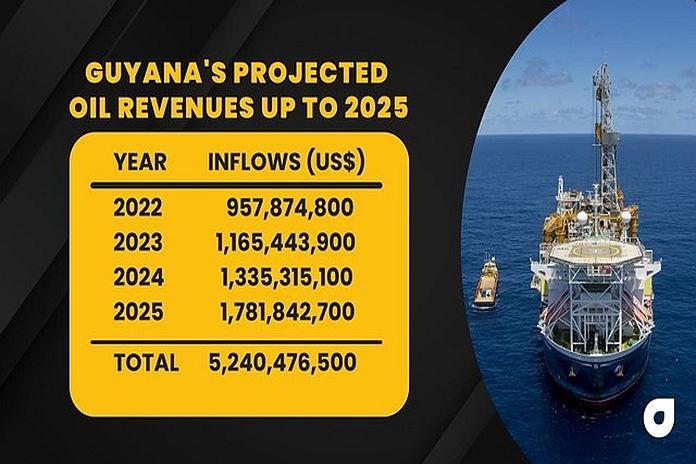By Kemol King
GEORGETOWN, Guyana, (DPI) – Guyana expects a tsunami of revenue inflows to its Natural Resource Fund (NRF), in the next four years, amounting to twice the size of its $552.9 billion 2022 budget.
The projections are captured in budget 2022, which was recently tabled in the National Assembly by senior minister in the office of the president with responsibility for finance, Dr Ashni Singh.
Guyana expects US$957,874,800 revenues in 2022, US$1,165,443,900 in 2023, US$1,335,315,100 in 2024, and US$1,781,842,700 in 2025. These figures, accounting for profit oil, royalties and interests, amount to US$5,240,476,500. In Guyana’s currency, that amounts to nearly $1.1 trillion.
It may be difficult for the average person to fathom just how much money this is. The 2025 inflows alone, nearly eclipse Guyana’s 2021 budget.
Where will all this money come from?
Guyana currently has a Production Sharing Agreement (PSA) with ExxonMobil and its partners in the Stabroek Block, Hess Corporation and CNOOC Limited. It sets out a system for the division of the oil produced between the parties, and a royalty charged by the government, which functions like a tax on the price of every barrel of oil produced and sold.
During a five-hour-long reading on Wednesday, Dr Singh outlined the operations in the coming years which will be the source of Guyana’s oil revenues.
“The Stabroek Block currently has three identified production areas – Liza 1, Liza 2 and Payara. Production capacity is currently at 120,000 [barrels per day] bpd with the Liza Destiny [floating production, storage and offloading vessel] FPSO in operation.”
Production at the Liza Phase One operation has been going on since December 2019, and has gotten Guyana US$607 million in the past two years.
Production had been curtailed by equipment malfunctioning with led to flaring. A resolution of the issue by ExxonMobil and plans to increase the capacity of the Liza Destiny could see higher production levels in the future, and a likelihood for more revenues.
Dr Singh said: “The coming into operation of the Liza Unity FPSO early in 2022 will raise capacity to 340,000 bpd…”
That FPSO arrived in the Stabroek Block late last year, and has the potential to nearly triple Guyana’s current production, with corresponding increases in revenue. This is why Guyana expects to make more money in 2022 than it made in the past two years from oil production.
“The deployment of the Prosperity FPSO in 2024 will further raise capacity to 560,000 bpd,” the finance minister noted.
These three vessels account for all the production operations Guyana has approved. ExxonMobil has asked Guyana to approve a fourth operation, Yellowtail, which would have a nameplate capacity of 250,000 bpd.
“With the anticipated fourth production area, Yellowtail, estimates are poised to reach 810,000 bpd by 2026/2027 and additional developments under consideration could see us reaching 6 FPSOs producing one million bpd by 2030.”
This is consistent with public statements made by ExxonMobil and its partners for their production plans for the Stabroek Block, which holds over 10 billion oil-equivalent barrels. There is so much oil that ExxonMobil sees the potential for as many as 10 FPSOs operating all at once to develop the reserves, meaning one million bpd could be just half of the production rate Guyana could achieve if ExxonMobil moves forward with such aggressive production targets.
What does this mean for Guyana?
President Dr Mohamed Irfaan Ali, in his pre-budget address on Tuesday, said that the oil and gas industry must be leveraged to meet the goal of strengthening all sectors.
“We have made it very clear that revenues from the oil and gas sector must be used to make the other sectors more competitive, must be able and must be utilised in a way to expand the economic framework of our country, to improve our competitiveness, to enhance our sustainability, to build an economy that is standing on many different legs, that can withstand global shocks, that can weather storms when they come.”
Over the years, starting in 2022, some of Guyana’s oil revenues will be used to fund pressing development initiatives related to healthcare, education, infrastructure and other critical sectors, which will elevate Guyana to developed status within the framework of the president’s expanded Low Carbon Development Strategy, allowing for the provision of a good standard of living for all Guyanese.
This can be achieved with projects like gas-to-energy which will cut the cost of power in half; transport infrastructures such as upcoming four-lane highways and the new Demerara River Bridge which will increase connectivity and decrease traffic congestion; sustainable hospitals with the best trained medical personnel to provide world-class healthcare at little to no cost; and free education at Guyana’s premier public tertiary education institution, the University of Guyana.
This is what is possible for Guyana, with prudent management of Guyana’s oil revenues. Altogether, the provisions of the Natural Resource Fund Act 2021 establish a transparent, robust framework for this purpose, which makes parliamentary scrutiny the cornerstone of its management.





